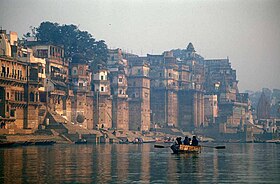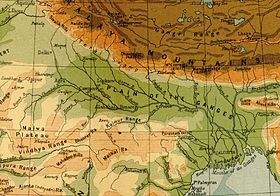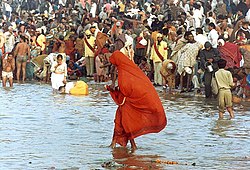Ганг
Ганг или Ганга је једна од најдужих река Индијског потконтинента. Река извире у западном делу Хималаја у индијској савезној држави Утаранчал, тече северним делом Индије, прелази у Бангладеш, и улива се у Бенгалски залив као делта у подручју Сундарбанс. Ганг је трећа река у свету по количини воде на ушћу.
| Ганг | |
|---|---|
 Ганг у Варанасију | |
 | |
| Опште информације | |
| Дужина | 2.525 km |
| Басен | 1.080.000 km2 |
| Пр. проток | 12 015 m3⁄s |
| Водоток | |
| Извор | Утараханд, Индија |
| В. извора | 3.892 m |
| Ушће | Бенгалски залив, Бангладеш |
| Географске карактеристике | |
| Држава/е | |
| Притоке | Varuna River, Tamsa River, Ramganga, Gomti River, Гагра, Gandak, Коси, Mahananda River, Јамуна, Сон, Bhagirathi River, Gandaki River, Padma River, Alaknanda River, Karmanasa River, Sarayu, Yarlung Tsangpo River, Burhi Gandak River, Punpun River, Rāmgangā River |
| Река на Викимедијиној остави | |

У хиндуизму, Ганг се сматра светом реком.[1] Ова река је такође извор живота за милионе Индијаца који живе дуж њеног тока и зависе о ње за своје свакодневне потребе.[2] Она се обожава као богиња „Ганг“ у Хиндуизму.[3] Она је исто тако била историјски важна, са мноштвом бивших покрајинским или империјалним престоницама (као што су[4] Канауж, Кампилја, [4] Кара, Алахабад, Каши, Патна, Хажипур, Мунгер, Багалпур, Муршидабад, Бахарампур, Набадвип, Саптаграм, Колката и Дака) лоцираним на њеним обалама.
Ганг је рангиран као пета најзагађенија река на свету 2007. Загађење угрожава не само људе, него и више од 140 рибљих врста, 90 амфибијских врста и угрожену врсту индијског речног делфина.[5] Нивои фекалних колиформи од људског отпада у водама реке у близини Варанасија су више од сто пута већи од званичног лимита Индијске владе.[5] Акциони план Ганга, је једна од иницијатива за заштиту животне средине усмерена на чишћење реке, која до сад није била успешна,[6] услед корупције, недостатка техничке стручности, лошег планирања животног окружења, и недостатка подршке локалних верских власти.
Географске карактеристике
уредиГанг се обликује спајањем пет малих река на јужним обронцима Хималаја; Багирати, Алакнанда, Мандакини, Даулиганга и Пиндар, у индијској држави Утараханд.[7][8] Два највеће су Алакнанда и Багирати, Алакнанда извире 50 km северно од хималајског врха Нанда Деви, а Багирати извире на 3000 м надморске висине, испод ледника Ганготри ког Хиндуси сматрају светим.[9] За извор Ганга се сматра место Гаумук које лежи 21 km југоисточно од Ганготрија, где се спајају Алакнанда и Багирати, тек одатле се река зове Ганг.
Ганг од обронака Хималаја тече готово праволинијски у смеру југоистока према Бенгалском заливу. Поречје Ганга покрива четвртину Индије, дела који је најгушће насељен у ком живи стотине милиона људи. У њему су се рађале и умирале историјске цивилизације као што је Мауријско царство (322. п. н. е.) све до Могулског царства из 16. века.[9] Ганг протиче кроз индијску државу Утар Прадеш где прима своју највећу десну притоку Јамуна код Алахабада, ту добија и три велике леве притоке; Рамгангу, Гомти и Гагару.[9]
Након тог река тече кроз државу Бихар где прима притоке са Хималаје; Гандаки, Бури Гандак, Гугри и Коши и најважнију јужну притоку Сон. Након тог река тече кроз последњу индијску државу Западни Бенгал, где прима задњу индијску притоку Махананду.[9]
У свом доњем делу, река тече кроз Бангладеш, ту се спаја са Брамапутром и скреће на југ. Заједничка река се одатле зове Падма, која код главног града Бангладеша Даке добија велику притоку Мегну (одатле се река зове Мегна) и почиње формирати највећу делту на свету - Делта Ганга, којом се улива у Индијски океан преко Бенгалског залива.[9]
Део делте уз море, са највећом шумом мангрове на свету познатом као Сундарбанс и Индија и Бангладеш прогласили су Националним парком, који је УНЕСКО уврстио у Светску баштину, и то 1987. индијски део, а 1997. и део који припада Бангладешу.[9]
Геологија
уредиИндијски потконтинент лежи на Индијској тектонској плочи, мањој плочи унутар Индо-аустралијске плоче.[10] Њени дефинициони геолошки процеси почели су пре седамдесет и пет милиона година, када је, као део јужног потконтинента Гондвана, започео североисточно померање - током педесет милиона година - преко тада неформираног Индијског океана.[10] Накнадна колизија потконтинента са Евроазијском плочом и субдукција испод ње, произвели су издизање Хималаја, највишег планинског ланца на планети.[10] У бившем морском дну непосредно јужно од Хималаја, кретање плоча је креирало огромно корито, које, након што је постепено напуњено седиментима које је носиле реке Инд и Ганг са њиговим притокама,[11] сад формира Индо-ганшку низију.[12]
Индо-ганшка низија је геолошки позната као прегибна ивица или прегибни слив.[13]
Види још
уредиРеференце
уреди- ^ Alter, Stephen (2001), Sacred Waters: A Pilgrimage Up the Ganga River to the Source of Hindu Culture, Houghton Mifflin Harcourt Trade & Reference Publishers, ISBN 978-0151005857, Приступљено 30. 7. 2013
- ^ „US TV host takes dig at Ganges”. Zeenews.com. 16. 12. 2009. Приступљено 4. 7. 2012.
- ^ Bhattacharji & Bandyopadhyay 1995, стр. 54
- ^ а б Ghosh 1990.
- ^ а б Rice, Earle (2012), The Ganges River, Mitchell Lane Publishers, Incorporated, стр. 25, ISBN 978-1612283685
- ^ "Clean Up Or Perish" Архивирано на сајту Wayback Machine (3. новембар 2011), The Times of India, 19 March 2010
- ^ „Ganges River”. Encyclopædia Britannica (Encyclopædia Britannica Online Library изд.). 2011. Приступљено 23. 4. 2011.
- ^ Penn 2001, стр. 88
- ^ а б в г д ђ „Ganges River”. Encyclopædia Britannica (Encyclopædia Britannica Online Library изд.). 2011. Приступљено 16. 11. 2015.
- ^ а б в Ali & Aitchison 2005.
- ^ Dikshit & Schwartzberg 2007, стр. 7
- ^ Prakash, B.; Kumar, Sudhir; Rao, M. Someshwar; Giri, S. C. (2000). „Holocene tectonic movements and stress field in the western Gangetic plains” (PDF). Current Science. 79 (4): 438—49.
- ^ Dmowska 2003, стр. 14
Литература
уреди- Dmowska, Renata (2003). Advances in Geophysics. Academic Press. стр. 14. ISBN 978-0120188468. Приступљено 6. 5. 2011.
- Bhattacharji, Sukumari; Bandyopadhyay, Ramananda (1995). Legends of Devi. Orient Blackswan. стр. 54. ISBN 978-8125007814. Приступљено 27. 4. 2011.
- Abraham, Wolf-Rainer. „Megacities as Sources for Pathogenic Bacteria in Rivers and Their Fate Downstream” (PDF). International Journal of Microbiology. 2011 (798292): 1—13. doi:10.1155/2011/798292.
- Ali, Jason R.; Aitchison, Jonathan C. (2005). „Greater India”. Earth-Science Reviews. 72 (3–4): 169—88. doi:10.1016/j.earscirev.2005.07.005.
- Alley, Kelly D. (2002). On the banks of the Gaṅgā: when wastewater meets a sacred river. University of Michigan Press. ISBN 978-0472068081. Приступљено 26. 7. 2011.
- Alter, Stephen (2001). Sacred waters: a pilgrimage up the Ganges River to the source of Hindu culture. Harcourt. ISBN 978-0151005857. Приступљено 26. 7. 2011.
- Arnold, Guy (2000). World Strategic Highways (1st изд.). Fitzroy Dearborn. стр. 223—27. ISBN 978-1579580988. doi:10.4324/9781315062204.
- Berga, L. (2006). Dams and Reservoirs, Societies and Environment in the 21st Century. Proceedings of the International Symposium on Dams in the Societies of the 21st Century, 22nd International Congress on Large Dams (ICOLD). Barcelona, Spain: Taylor & Francis. ISBN 978-0415404235.
- Bharati, Radha Kant (2006). Interlinking of Indian rivers. Lotus. ISBN 978-8183820417.
- Blurton, T. Richard (1993). Hindu art. Harvard University Press. ISBN 978-0674391895. Приступљено 26. 7. 2011.
- Brichieri-Colombi, Stephen; Bradnock, Robert W. (2003). „Geopolitics, water and development in South Asia: cooperative development in the Ganges–Brahmaputra delta”. The Geographical Journal. 169 (1): 43—64. doi:10.1111/1475-4959.t01-1-00002.
- Brune, James N. (1993). „The seismic hazard at Tehri dam”. Tectonophysics. Elsevier. 218 (1–3): 281—86. doi:10.1016/0040-1951(93)90274-N.
- Caso, Frank; Wolf, Aaron T. (2010). Freshwater Supply Global Issues. Infobase. ISBN 978-0816078264.
- Chakrabarti, Dilip K. (2001). „4 The Archaeology of West Bengal: The Bhagirathi Mouth and the Midnapur Coast”. Archaeological Geography of the Ganga Plain: The Lower and the Middle Ganga. Permanent Black. ISBN 978-8178240169.
- Darian, Steven G. (2001). The Ganges in myth and history. Motilal Banarsidass. ISBN 978-8120817579. Приступљено 26. 7. 2011.
- Dhungel, Dwarika Nath; Pun, Santa B. (2009). The Nepal-India Water Relationship: Challenges. Springer. ISBN 978-1402084027. Приступљено 27. 4. 2011.
- Dikshit, K.R.; Schwartzberg, Joseph E. (2007), „India: The Land”, Encyclopædia Britannica, стр. 1—29
- Dudgeon, David (2005). „River Rehabilitation for Conservation of Fish Biodiversity in Monsoonal Asia” (PDF). Ecology and Society. 10 (2:15).
- Eck, Diana L. (1982). Banaras, city of light. Columbia University. ISBN 978-0231114479. Приступљено 26. 7. 2011.
- Eck, Diana (1998). „Gangā: The Goddess Ganges in Hindu Sacred Geography”. Ур.: Hawley, John Stratton; Wulff, Donna Marie. Devī: Goddesses of India. University of California / Motilal Banarasidass. стр. 137—53. ISBN 978-81-208-1491-2.
- Elhance, Arun P. (1999). Hydropolitics in the Third World: Conflict and Cooperation in International River Basins. United States Institute of Peace. ISBN 978-1878379900.
- Gardner, Gary (2003). „Engaging Religion in the Quest for a Sustainable World”. Ур.: Bright, Chris; et al. State of the World: 2003 (Special 20th anniversary изд.). Norton. стр. 152-76. ISBN 978-0393323863.
- Ghosh, A. (1990). An Encyclopaedia of Indian Archaeology. Brill. стр. 334. ISBN 978-9004092648.
- Gupta, Avijit (2007). Large rivers: geomorphology and management. Wiley. ISBN 978-0-470-84987-3. Приступљено 23. 4. 2011.
- Haberman, David L. (2006). River of Love in an Age of Pollution: The Yamuna River of Northern India. University of California. ISBN 978-0520247901.
- Hill, Christopher V. „3 The Mauryan Empire and the Classical Age – Irrigation in Early India”. South Asia: an environmental history. стр. 32. ISBN 978-1851099252.
- Hillary, Sir Edmund (1980). From the ocean to the sky. Ulverscroft. ISBN 978-0708905876. Приступљено 26. 7. 2011.
- Jain, Sharad K.; Agarwal, Pushpendra K.; Singh, Vijay P. (2007). Hydrology and water resources of India. Springer. ISBN 978-1402051791.
- Krishna Murti, C. R. (1991). The Ganga, a scientific study. Gaṅgā Pariyojanā Nideśālaya; India Environment Research Committee. Northern Book Centre. ISBN 978-8172110215.
- Kumar, Rakesh; Singh, R. D.; Sharma, K. D. (10. 9. 2005). „Water Resources of India” (PDF). Current Science. Bangalore: Current Science Association. 89 (5): 794—811. Архивирано (PDF) из оригинала 14. 10. 2013. г. Приступљено 13. 10. 2013.
- Los Angeles County Museum of Art; Pal, Pratapaditya (1988). Indian Sculpture: 700–1800. University of California Press. ISBN 978-0520064775. Приступљено 26. 7. 2011.
- Maclean, Kama (2008). Pilgrimage and power: the Kumbh Mela in Allahabad, 1765–1954. Oxford University Press US. ISBN 978-0195338942. Приступљено 27. 7. 2011.
- Markandya, Anil; Murty, Maddipati Narasimha (2000). Cleaning-up the Ganges: a cost-benefit analysis of the Ganga Action Plan. Oxford University Press. ISBN 978-0195649451. Приступљено 29. 7. 2011.
- Mirza, M. Monirul Qader (2004). The Ganges water diversion: environmental effects and implications. Dordecht: Springer. стр. 1—6. ISBN 978-9048166657. doi:10.1007/978-1-4020-2792-5.
- Newby, Eric (1998). Slowly down the Ganges. Lonely Planet. ISBN 978-0864426314. Приступљено 26. 7. 2011.
- Pal, Pratapaditya (1997). Divine images, human visions: the Max Tanenbaum collection of South Asian and Himalayan art in the National Gallery of Canada. National Gallery of Canada. ISBN 978-1896209050. Приступљено 27. 7. 2011.
- Parua, Pranab Kumar (2009), „14 Necessity of Regional Co-operation”, The Ganga: water use in the Indian subcontinent, Springer, стр. 267—72, ISBN 978-9048131020
- Prakash, Gyan (1999). „6 Technologies of Government”. Another Reason: Science and the Imagination of Modern India. ISBN 978-0691004532.
- Puttick, Elizabeth (2008). „Mother Ganges, India's Sacred River”. Ур.: Emoto, Masaru. The Healing Power of Water. Hay House. стр. 241—52. ISBN 978-1401908775.
- Rahaman, M.M. (2009), „Integrated Ganges Basin Management: conflicts and hope for regional development”, Water Policy, 11 (2): 168—90, doi:10.2166/wp.2009.012, Архивирано из оригинала 27. 9. 2011. г., Приступљено 5. 9. 2017
- Rahaman, M.M. (2009), „Principles of transboundary water resources management and Ganges Treaties: An Analysis”, International Journal of Water Resources Development, 25 (1): 159—73, doi:10.1080/07900620802517574
- Rodda, John C.; Ubertini, Lucio (2004). „The Basis of Civilization: Water Science?”. IAHS publication no. 286. Wallingford, Oxfordshire, UK: International Association of Hydrological Sciences, IAHS International Commission on Water Resources Systems: 165. ISBN 978-1901502572.
- Sack DA, Sack RB, Nair GB, Siddique AK (2004), „Cholera”, Lancet, 363 (9404): 223—33, PMID 14738797, doi:10.1016/S0140-6736(03)15328-7
- Salman, Salman M. A.; Uprety, Kishor (2002). Conflict and cooperation on South Asia's international rivers: a legal perspective (PDF). World Bank Publications. ISBN 978-0821353523. Приступљено 27. 4. 2011.
- Sharma, Ramesh C.; Bahuguna, Manju; Chauhan, Punam (2008). „Periphytonic diversity in Bhagirathi:Preimpoundment study of Tehri dam reservoir”. Journal of Environmental Science and Engineering. 50 (4): 255—62. PMID 19697759.
- Sheth, Jagdish N. (2008). Chindia Rising. Tata McGraw-Hill. ISBN 978-0070657083.
- Singh, Munendra; Singh, Amit K. (2007), „Bibliography of Environmental Studies in Natural Characteristics and Anthropogenic Influences on the Ganga River”, Environ Monit Assess, 129: 421—32, doi:10.1007/s10661-006-9374-7
- Singh, Nirmal T. (2005). Irrigation and soil salinity in the Indian subcontinent: past and present. Bethlehem, PA: Lehigh University. ISBN 978-0934223782.
- Stone, Ian (2002). Canal Irrigation in British India: Perspectives on Technological Change in a Peasant Economy. CUP. ISBN 978-0521526630. Приступљено 26. 7. 2011.
- Suvedī, Sūryaprasāda (2005). International watercourses law for the 21st century: the case of the river Ganges basin. Ashgate. ISBN 978-0754645276.
- Thapar, Romila (октобар 1971). „The Image of the Barbarian in Early India”. Comparative Studies in Society and History. CUP. 13 (4): 408—36. JSTOR 178208. doi:10.1017/s0010417500006393.
- Tiwari, R. C. (2008). „Environmental Scenario in India”. Ур.: Dutt, Ashok K. Explorations in Applied Geography. PHI Learning. ISBN 978-81-203-3384-0.
- Wangu, Madhu Bazaz (2003). Images of Indian goddesses: myths, meanings, and models. Abhinav Publications. ISBN 978-8170174165. Приступљено 26. 7. 2011.
- Wink, André (2002). „From the Mediterranean to the Indian Ocean: Medieval History in Geographic Perspective”. Comparative Studies in Society and History. 44 (3): 416—45. JSTOR 3879375. doi:10.1017/s001041750200021x.
- Berwick, Dennison. A Walk Along the Ganges. Dennison Berwick. ISBN 978-0713719680.
- Cautley, Proby Thomas (1864). Ganges canal. A disquisition on the heads of the Ganges of Jumna canals, North-western Provinces. London, Printed for Private circulation.
- Fraser, James Baillie (1820). Journal of a tour through part of the snowy range of the Himala Mountains, and to the sources of the rivers Jumna and Ganges. Rodwell and Martin, London.
- Hamilton, Francis (1822). An account of the fishes found in the river Ganges and its branches. A. Constable and company, Edinburgh.
- Singh, Indra Bir (1996), „Geological Evolution of the Ganga Plain”, Journal of the Palaentological Society of India, 41: 99—137
Спољашње везе
уреди- Ganges River na portalu Encyclopædia Britannica
- On Thinner Ice 如履薄冰: signs of trouble from the Water Tower of Asia, where headwaters feed into all the great rivers of Asia (by GRIP, Asia Society and MediaStorm)
- Ganga in the Imperial Gazetteer of India, 1909
- Melting Glaciers Threaten Ganga
- Bibliography on Water Resources and International Law
- Ganga Ma: A Pilgrimage to the Source на сајту YouTube
- An article about the land and the people of the Ganga
- The impacts of water infrastructure and climate change on the hydrology of the Upper Ganga River Basin
- Bahar Dutt, "Saving the Ganges" на сајту YouTube CNN–IBN Live 5 May 2012.
- The Ganges: A Journey into India
- It’s scientifically validated now; Ganga water is ‘holy’!